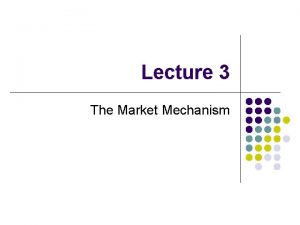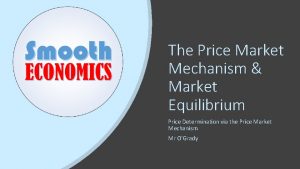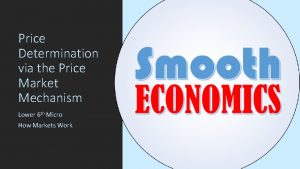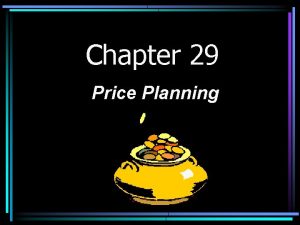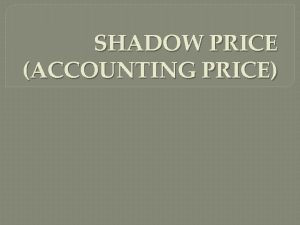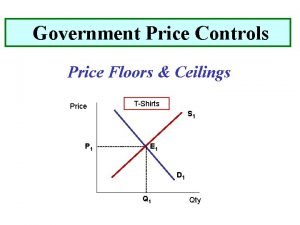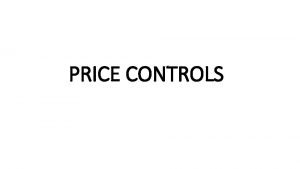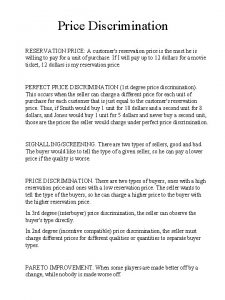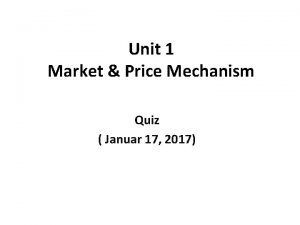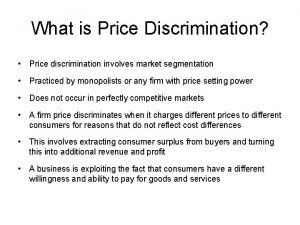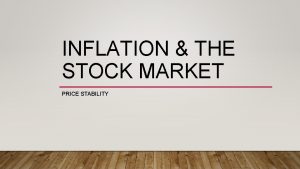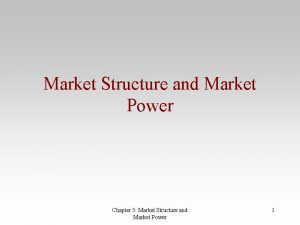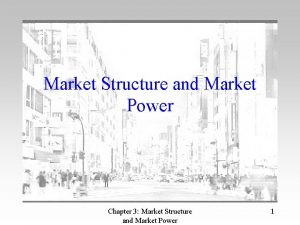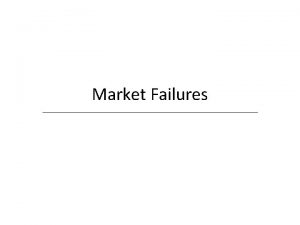Chapter 3 THE MARKET MECHANISM Price Mechanism Price









































- Slides: 41

Chapter 3 THE MARKET MECHANISM

Price Mechanism • Price mechanism or market mechanism is an economic system in which relative prices are constantly changing to reflect changes in supply and demand for different goods and services. • • There are three markets: 1. Factor market 2. Product market 3. Financial market

• MARKETS

Transaction costs which affect construction • Search costs=the cost of having to find out what is an offer • Specification costs= to assure the desired quantity and quality • Contract costs=finding and creating conditions to clarify what is expected and cover contingencies • Selection costs=cost of choosing the best tender • Monitoring costs=to measure and control price, timing and quality • Enforcement costs=the legal bills relating to breached contracts

Graphical analysis • Supply and Demand analysis

DEMAND SUPPLY Economics is about the choices people make to cope with scarcity. These choices are guided by cost and benefits and are coordinated through markets. 1. DEMAND • If you demand something then you a) want it, b) can afford it and c) have made a definite plan to buy it. • The quantity demanded of a good or service is the amount that consumers plan to buy during a given time period at a particular price.

What Determines Buying Plans The main factors determine customers buying plans are: • The price of the good • The prices of related goods • Expected future prices • Income • Population • Preferences

The Law of Demand: • Other things remain the same, the higher the price of a good, the smaller is the quantity demanded. • Why does a higher price reduce the quantity demanded ? For two reasons: 1. Substitution effect 2. Income effect

1. Substitution effect: When the price of a good rises, other things remaining the same, its relative price – opportunity cost –rises. When the price of a good rises people buy less of that good and more of its substitutes. 2. Income effect: When the price of a good rises, other things remaining the same, the price changes relative to peoples incomes. So, people can not afford to buy all the things they previously bought.

Demand Curve and Demand Schedule: • It is important to know the distinction between demand the quantity demanded. • Demand refers to the entire relationship between the quantity demanded and the price of a good, and it is illustrated by the demand curve and the demand schedule. • Quantity demanded refers to a point on a demand curve, i. e. the quantity demanded at a particular price.

• Demand Curve shows the relationship between the quantity demanded of a good and its price when all other influence on consumers planned purchases remain the same. • A demand schedule lists the quantities demanded at each different price when all the other influences on consumers’ planned purchases such as income, population, preferences, and future prices remain the same.

The Demand Curve 6 5 Price 4 3 2 Demand for tapes D 1 0 2 4 6 Quantity 8 10 • The demand curve slopes downward: As price decreases, the quantity demanded increases.

• Change in Demand When any factor that influences buying plans other than the price of the good changes, there is a change in demand. Price An Increase in Demand D' D Quantity

Factors Bringing a Change in Demand 1. Prices of Related Goods • The quantity of tapes that consumers plan to buy depends in part on the prices of substitutes for tapes. A substitute is a good that can be used in place of another good. For example, coke is a substitute for Pepsi. , CD is a substitute for tape, and bus is a substitute for train. If the price of a substitute for tape goes up people buys less of the substitute and more tapes. The demand for tapes increases. • The quantity of tapes that people plan to buy also depends on the prices of complements of tapes. A complement is a good that is used in conjunction with another good. Hamburgers and fries, tapes and walkmans are complements. If the price of walkman falls the demand for tapes increases.

2. Expected Future Prices If the price of a good is expected to rise in the future, and if the good can be stored, the current demand for this good increase but the future demand decreases i. e. people retime their purchase. 3. Income When income increases consumers buy more of most goods, and when income decreases, they buy less of most goods. Increase in income does not increase demand for all goods. It increases demand for normal goods and it decreases demand for inferior goods. Eg. air travel vs bus trips.

4. Population Demand also depends on the size and the age structure of the population. The larger the population the greater the demand for all goods and services and vs. Also the age distribution of the population affect the demand for goods consumed by each group. 5. Preferences Demand also depends on preferences. Preferences are an individual’s taste and choice.

• A Change in the Quantity Demanded Versus a Change in Demand A point on the demand curve shows the quantity demanded at a given price. So a movement along the demand curve shows a change in the quantity demanded. The entire demand curve shows demand. So, a shift of the demand curve shows a change in demand.

A Change in the Quantity Demanded Versus a Change in Demand Price • • • D 2 D 1 D 0 Quantity

• When the price of a good change, there is a movement along the demand curve and a change in the quantity demanded. When any other influence on buying plans changes, there is a shift of the demand curve and a change in demand. An increase in demand shifts the demand curve rightward (from D 0 to D 1). A decrease in Demand shifts the demand curve leftward (from D 0 to D 2).

2. SUPPLY • If a firm supplies a good or service, the firm 1. Has the resources and technology to produce it 2. Can profit from producing it 3. Has made a definite plan to produce it and sell it • The quantity supplied of a good or service is the amount that producers plan to sell during a given time period at a particular price. The quantity supplied is not necessarily the same amount as the quantity actually sold.

• What Determines Selling Plans? The amount of any particular good and service that producers plan to sell depends on many factors. The main ones are: 1. The price of the good 2. The prices of resources used to produce the good 3. The prices of related goods produced 4. Expected future prices 5. The number of suppliers 6. Technology

• The Law of Supply Other things remaining the same, the higher the price of a good, the greater is the quantity supplied. • Supply Curve and the Supply Schedule – The term supply refers to the entire relationship between the quantity supplied and the price of a good, and it is illustrated by the supply curve and the supply schedule. – The term quantity supplied refers to a point on a supply curve –quantity supplied at a particular price.

Price The Supply Curve Quantity A supply curve shows the relationship between the quantity supplied of a good and its price when all other influences on producers planned sales remain the same.

• A Change in Supply When any factor that influences selling plans other than the price of the good changes, there is a change in supply. There are five key factors that change supply. 1. Prices of Productive Resources If the prices of productive resources goes up supply decreases. Eg. A rise in the minimum wage decreased the supply of hamburgers.

2. Prices of Related Goods Produced The prices of related goods and services that firms produce influence supply. If two products are substitutes in production, increase in price of one product decreases the supply of its substitution. For eg. if the price of prerecorded tapes rises, the supply of blank tapes decreases. Blank tapes and prerecorded tapes are substitutes in production. If two products are complementary in production, the increase in price in one product increases the supply of this product as well as the supply of the complementary products.

3. Expected Future Prices If the price of a good expected to increase the current supply decreases. 4. The Number of Suppliers Supply also depends on the number of suppliers. The larger the number of firms that produce a good the greater the supply of the good. 5. Technology New technologies lower the cost of producing products, therefore they increase supply of products.

An Increase in Supply S 1 Price S 0 Quantity

• A Change in Quantity Supplied Versus a Change in Supply A point on the supply curve shows the quantity supplied at a given price. So a movement along the supply curve shows a change in the quantity supplied. The entire supply curve shows supply. So a shift of the supply curve shows a change in supply.

Price A Change in the Quantity Supplied Versus a Change in Supply S 2 S 0 S 1 • Quantity

• When the price of the good changes , there is a movement along the supply curve and a change in the quantity supplied. When any other influence on selling plans changes, there is a shift of the supply curve and a change in supply. An increase in supply shifts the supply curve rightwards. A decrease in supply shifts the supply curve leftward.

MARKET EQUILIBRIUM • An equilibrium is a situation in which opposing forces balance each other. Equilibrium in a market occurs when the price balances the plans of buyers and sellers. • The equilibrium price is the price at which the quantity demanded equals the quantity supplied. The equilibrium quantity is the quantity bought and sold at the equilibrium price.

Figure 3. 4(page 52): The determination of Equilibrium price Price 6 S D 5 • 4 • • 3 • 2 Surplus at 3 million tapes Equilibrium • Shortage at 3 million tapes 1 0 2 4 6 8 10 Quantity

• Price as a Regulator The price of a good regulates the quantities demanded and supplied. If the price is too high, the quantity supplied exceeds the quantity demanded, if the price is too low, the quantity demanded exceeds the quantity supplied. There is one price at which the quantity demanded equals the quantity supplied. This is called equilibrium price. • Price Adjustment If the price is below equilibrium there is a shortage and if the price is above equilibrium there is a surplus. 1. A shortage forces the price up 2. A surplus forces the price down

Predicting Changes in Price and Quantity • A Change in Demand 1. When demand increases, both the price and the quantity increase 2. When demand decreases, both the price and the quantity decreases

6 Figure 3. 5: The Effects of a Change in Demand S Price 5 4 • 3 2 1 D 0 0 2 4 6 8 D 1 10 12 Quantity 14

• A Change in Supply 1. When supply increases, the quantity increases and the price falls. 2. When supply decreases, the quantity decreases and the price rises.

Equilibrium S 0 Price 6 S 1 5 4 • 3 • • 2 D 1 0 2 4 6 Excess Supply 8 10 Quantity

A Change in Both Demand Supply Change in the Same Direction • When both demand supply increases the quantity increases and the price increases, decreases, or remains constant. • When both demand supply decrease, the quantity decreases and the price increases, decreases, or remains constant.

The Effects of an Increase in Both Demand Supply S 0 Price 6 S 1 5 4 • • 3 2 D 1 D 0 1 0 2 4 6 8 10 Quantity

Demand Supply Change in Opposite Directions • When demand decreases and supply increases, the price falls and the quantity increases, decreases, or remains constant. • When demand increases and supply decreases, the price rises and the quantity increases decreases, or remains constant.

The Effects of a Decrease in Demand an Increase in Supply S 0 Price 6 S 1 • 5 4 • 3 • 2 1 D 1 0 2 4 6 8 10 D 0 Quantity
 Ano ang ibang katawagan ng price ceiling
Ano ang ibang katawagan ng price ceiling Leader follower challenger nicher
Leader follower challenger nicher Steps in market segmentation targeting and positioning
Steps in market segmentation targeting and positioning Market mechanism
Market mechanism Hình ảnh bộ gõ cơ thể búng tay
Hình ảnh bộ gõ cơ thể búng tay Slidetodoc
Slidetodoc Bổ thể
Bổ thể Tỉ lệ cơ thể trẻ em
Tỉ lệ cơ thể trẻ em Voi kéo gỗ như thế nào
Voi kéo gỗ như thế nào Tư thế worm breton
Tư thế worm breton Hát lên người ơi
Hát lên người ơi Môn thể thao bắt đầu bằng chữ f
Môn thể thao bắt đầu bằng chữ f Thế nào là hệ số cao nhất
Thế nào là hệ số cao nhất Các châu lục và đại dương trên thế giới
Các châu lục và đại dương trên thế giới Công thức tiính động năng
Công thức tiính động năng Trời xanh đây là của chúng ta thể thơ
Trời xanh đây là của chúng ta thể thơ Cách giải mật thư tọa độ
Cách giải mật thư tọa độ Phép trừ bù
Phép trừ bù độ dài liên kết
độ dài liên kết Các châu lục và đại dương trên thế giới
Các châu lục và đại dương trên thế giới Thể thơ truyền thống
Thể thơ truyền thống Quá trình desamine hóa có thể tạo ra
Quá trình desamine hóa có thể tạo ra Một số thể thơ truyền thống
Một số thể thơ truyền thống Cái miệng nó xinh thế
Cái miệng nó xinh thế Vẽ hình chiếu vuông góc của vật thể sau
Vẽ hình chiếu vuông góc của vật thể sau Nguyên nhân của sự mỏi cơ sinh 8
Nguyên nhân của sự mỏi cơ sinh 8 đặc điểm cơ thể của người tối cổ
đặc điểm cơ thể của người tối cổ Thế nào là giọng cùng tên? *
Thế nào là giọng cùng tên? * Vẽ hình chiếu đứng bằng cạnh của vật thể
Vẽ hình chiếu đứng bằng cạnh của vật thể Tia chieu sa te
Tia chieu sa te Thẻ vin
Thẻ vin đại từ thay thế
đại từ thay thế điện thế nghỉ
điện thế nghỉ Tư thế ngồi viết
Tư thế ngồi viết Diễn thế sinh thái là
Diễn thế sinh thái là Các loại đột biến cấu trúc nhiễm sắc thể
Các loại đột biến cấu trúc nhiễm sắc thể Số.nguyên tố
Số.nguyên tố Tư thế ngồi viết
Tư thế ngồi viết Lời thề hippocrates
Lời thề hippocrates Thiếu nhi thế giới liên hoan
Thiếu nhi thế giới liên hoan ưu thế lai là gì
ưu thế lai là gì Khi nào hổ con có thể sống độc lập
Khi nào hổ con có thể sống độc lập



